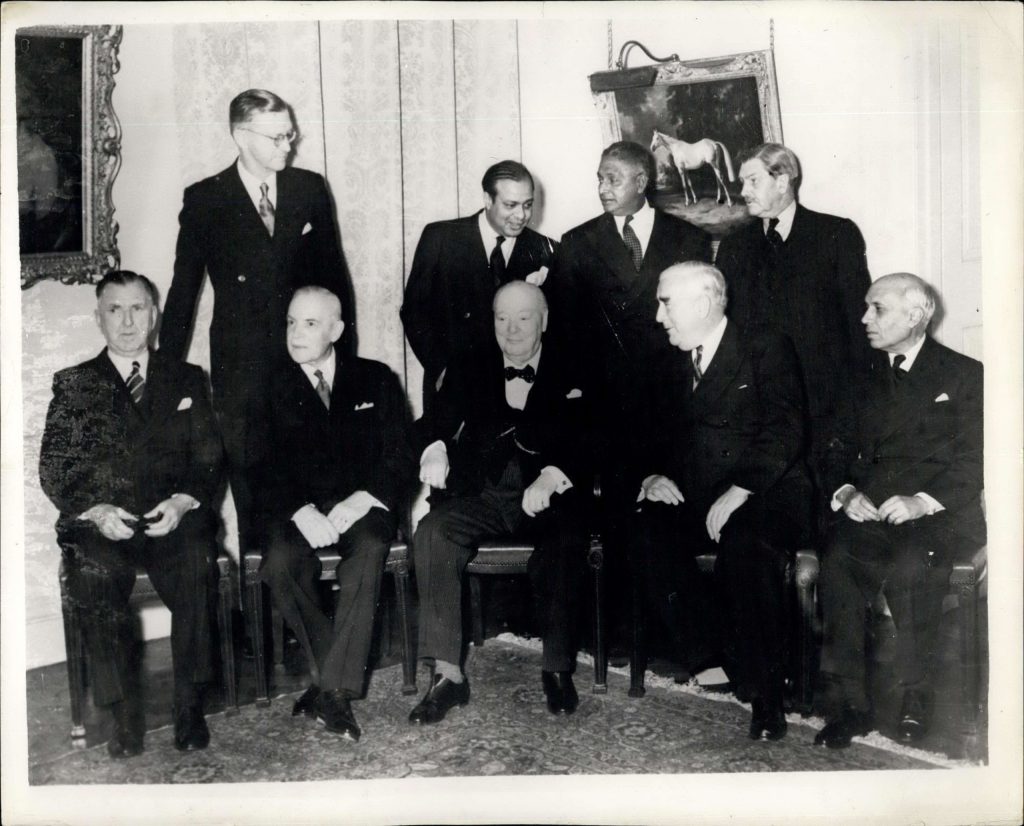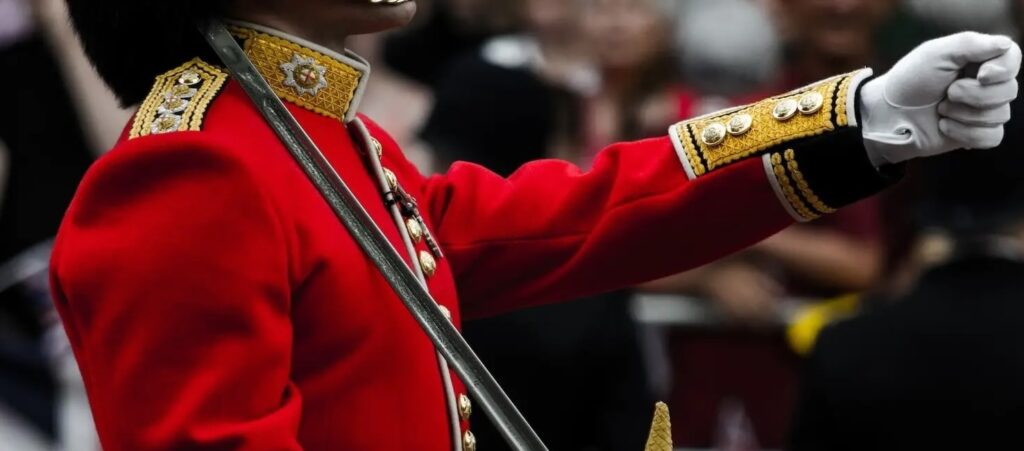Finest Hour 191
“Every Effort Must Be Made”

Opening Of The Commonwealth Conference. Sir Winston Churchill presided over the first meeting of the Commonwealth Prime Ministers' Conference. 31 Jan 1955, © E0MEGC via Alamy.com
January 1, 1970
Finest Hour 191, First Quarter 2021
Page 27
By Zareer Masani
Dr. Zareer Masani (D.Phil., Oxon.) is an author and historian who has written biographies of Indira Gandhi and Lord Macaulay.
A favourite trope of postcolonial academics and their left-liberal public has been the alleged infamy of Britain’s most cherished hero, Winston Churchill, charged with everything from mere racism to actual genocide. The worst accusation has been that of deliberately starving Bengalis to death in the famous famine of 1943.
Photo above: Opening Of The Commonwealth Conference. Posed Group: Sir Winston Churchill presided over the first meeting of the Commonwealth Prime Ministers’ Conference. Standing L-R:- Mr CR Swart (South African Minister of Justice); Mr Mohammed Ali (Pakistan); Sir John Kotelawala (Ceylon); and Sir Godfrey Huggins (Central Africa); Seated L-R:- Mr SC Holland (New Zealand); Mr L St Laurent (Canada); Sir Winston Churchill); Mr RG Menzies (Australia) and Mr Nehru (India), 31 Jan 1955, © E0MEGC via Alamy.com
Churchill’s first encounter with India dates as far back as the 1890s, when he was a young subaltern in the British Army. His early impressions were not encouraging. He wrote home about “this tedious land of India” and about the “great work” Britain was doing with “her high mission to rule these primitive but agreeable races for their welfare and our own.” He travelled extensively across the subcontinent, from the Swat Valley of the North West Frontier, through the central United Provinces, down to the Deccan and Bangalore. “You could lift the heat with your hands,” he complained. “It sat on your shoulders like a knapsack, it rested on your head like a nightmare.”1

2024 International Churchill Conference
Political Battles
How did this early aversion evolve into Chuchill’s deep-seated later conviction of India’s central role as the jewel in Britain’s imperial crown? His first major political encounter with India came in the immediate aftermath of the infamous Jallianwala massacre in the Punjab in April 1919, when a British-led firing squad had shot dead 367 unarmed protesters and wounded thousands more. The massacre had divided British public opinion down the centre, with the Liberals, then leading a coalition government, condemning General Dyer, the British officer responsible, while most Conservatives and diehard imperialists rallied to Dyer’s defence. Surprisingly, given his later views, Churchill, then Liberal Secretary for War, led the House of Commons debate condemning Dyer for what he termed a “monstrous” and “un-British” atrocity and had him recalled and cashiered from the Indian Army.2
By the time Churchill next addressed the Indian question, he had become a Conservative backbencher. The occasion was the three Round Table Conferences held in London from 1930 to 1933 to try to agree on a new constitutional settlement with Indian representatives. While the Indian National Congress, led by Gandhi, was demanding independence and claimed to speak for all India, its claims were hotly contested by India’s 100 million Muslims, 60 million Untouchables, and 546 autonomous princes. While the British government would have liked a united India to evolve into self-governing dominion status, like Canada and Australia, the key hurdle was how to guarantee the rights of Indian minorities against majoritarian Hindu domination.
This dilemma found Churchill leading Tory backbench resistance to what he considered a surrender to Hindu Brahmin rule by Congress. In his speeches in Parliament and up and down the country, Churchill warned that anything like dominion status, or even the promise of it, would fracture the precious unity of the subcontinent, built so painstakingly by the Raj over a century and a half. Responsible government, he argued, required levels of literacy and education remote in India for at least a generation. India, he was convinced, with its multitude of languages, castes, and religions was even more diverse than Europe and thoroughly unsuited to Western-style, democratic self-government.3 Insofar as democracy proved incompatible with unity, India’s partition in 1947 was to prove Churchill right.Churchill fought a persistent rear-guard action against the passing of the Government of India Act of 1935, which embodied the constitutional concessions agreed to at the Round Table Conferences. While retaining separate electorates for Muslims, the Act granted provincial autonomy under popular ministries, to be elected by a much-expanded new electorate of thirty million. It also held out the hope of an All-India federation if the provinces and the autonomous princely states agreed. Though he was unable to halt the passing of the Act, Churchill’s opposition to it, which included filibustering in parliament, effectively cut him off from holding office in the national governments of either Ramsay MacDonald or Stanley Baldwin.
How far was this stand against Indian Home Rule driven by racism and prejudice? Churchill undoubtedly shared late Victorian assumptions about white, male Anglo-Saxon superiority, embodied in empire. While he expressed respect for Islam, as a fellow religion of the book, he considered Hinduism a barbaric, superstitious, and idolatrous system for ensuring the dominance of the Brahmin caste, the perpetuation of untouchability, and the subjugation of women. His very genuine concern for the rights of women is evident from his correspondence with Katherine Mayo. The American feminist’s book Mother India, castigating the oppression of Indian women, provoked a hostile, nationalist outcry in India. Churchill wrote to Mayo applauding her book and publicly endorsed her condemnation of Hindu-sanctioned child marriage.4
The Bengal Famine
Churchill’s revulsion at Hindu social and cultural practices was genuine, but it was a far cry from this to the accusation that he deliberately starved millions of Bengali Hindus a decade later in the famous Bengal Famine of 1943. Churchill had by then returned from the backbenches to lead Britain’s War Cabinet. The famine took place at the height of the war, with the Japanese already occupying Burma and invading the British Indian province of Bengal, bombing its capital, Calcutta, and patrolling its coast with submarines. The famine raged for about six months, from the summer of 1943 till the end of that year, and estimates of its victims have ranged from half a million upwards, depending on whether one included its indirect and long-term effects.
So how has an elderly British Prime Minister in poor health, five thousand miles away, fighting near annihilation in a world war, come to be charged with causing such a cataclysmic disaster? The attempt to lay this charge at Churchill’s door stems from the sensationalist book by the Bengali–American journalist Madhusree Mukerjee.5 As its title Churchill’s Secret War indicates, it was a largely conspiracist attempt to pin responsibility on the distant Churchill for undoubted mistakes on the ground in Bengal. The actual evidence shows that Churchill believed, based on the information he had been getting, that there was no food supply shortage in Bengal, but a demand problem caused by local mismanagement of the distribution system.
This was largely the result of wartime supply constraints, with most of Bengal’s boats commandeered or disabled, and uneasy relations between the elected, Muslim-led, coalition government of Bengal and its largely Hindu grain merchants, notorious for hoarding and speculation. Churchill had resisted the 1935 constitution granting Indian provinces autonomy; but, by the 1940s, he regarded the food situation in Bengal as primarily a matter for its elected ministry rather than Whitehall. Within the War Cabinet itself, Churchill’s role was one of broad oversight, rather than detailed management, so the idea that he had much influence on actual relief aid to Bengal is far-fetched, especially at the height of the war.
1943 had begun as a year of normal harvest, leaving the Bengal ministry sanguine about food supplies and the Viceroy’s government in Delhi reluctant to intervene, using its reserve powers. Once the Viceroy did intervene, the famine was rapidly brought under control and petered out within months. And it was Churchill who replaced the lethargic Lord Linlithgow as viceroy with the efficient and politically sensitive Field Marshal Wavell.
Not even Mukerjee blames Churchill for actually causing the Bengal Famine. He blames Churchill for compounding it by refusing to allow shipments of grain from Australia and Canada, bound for Europe, to be diverted to Bengal, but any map shows what folly it would have been for Australian ships bound for Europe to come anywhere near the Bay of Bengal and run the gauntlet of Japanese submarines.
The true facts about food shipments to Bengal, amply recorded in the British War Cabinet and Government of India archives, are that more than a million tons of grain arrived in Bengal between August 1943, when the War Cabinet first realised the severity of the famine, and the end of 1944, when the famine had petered out. This was food aid specifically sent to Bengal, much of it on Australian ships, despite strict food rationing in England and severe food shortages in the newly liberated regions of Italy and Greece. The records show that, far from seeking to starve India, Churchill and his cabinet sought every possible way to alleviate the suffering without undermining the war effort.
On 4 August 1943, when the War Cabinet chaired by Churchill first realised the enormity of the famine, it agreed that 150,000 tons of Iraqi barley and Australian wheat should be sent to Bengal, with Churchill himself insisting on 24 September that “something must be done.” Though emphatic “that Indians are not the only people who are starving in this war,” he agreed to send a further 250,000 tons, to be shipped over the next four months.
On 7 October, Churchill told the War Cabinet that one of the new viceroy’s first duties was to see to it “that famine and food difficulties were dealt with.” He wrote to Wavell the next day: “Every effort must be made, even by the diversion of shipping urgently needed for war purposes, to deal with local shortages.” By January 1944, Bengal had received a total of 130,000 tons of barley from Iraq, 80,000 tons of wheat from Australia, and 10,000 tons from Canada, followed by a further 100,000 from Australia. Then, on 14 February 1944, Churchill called an emergency meeting of the War Cabinet to see if more food aid could be sent to Bengal without wrecking Allied plans for the coming Normandy landings.
On 24 April 1944, the Cabinet minutes recorded: “the Prime Minister said that it was clear that His Majesty’s Government could only provide further relief for the Indian situation at the cost of incurring grave difficulties in other directions. At the same time, his sympathy was great for the sufferings of the people of India.” These were not empty words. A few days later, Churchill asked President Roosevelt for US shipping to supply Bengal, saying that he was “seriously concerned” about the famine, that Wavell still needed a million extra tons of grain, and that the wheat was available in Australia, but without ships to transport it. The request was refused by the US administration on the grounds that it needed all its shipping to supply the Pacific theatre and the impending D-Day landings.6
Despite such obstacles, by the end of 1944 Wavell’s much-requested one million additional tons had been secured from Australia and the allied South East Asia Command and shipped to Bengal. To Churchill must go the credit for appointing the man arguably most responsible for this success. British India’s most able and conscientious viceroy, Field Marshal Archibald Wavell, with his long and distinguished record of service in India, his intimate knowledge of its peoples and languages, and his experience of large-scale military logistics, was just the person to halt the Bengal famine in its tracks, drafting in the army to get food supplies moving quickly from surplus to deficit areas.
Words and Deeds
Much of the case against Churchill rests not on his actions, but on his words—namely, his various racist comments about Indians, and Bengalis in particular. Most of these have been taken out of context. Churchill was certainly no friend to Indian nationalist leaders, most of whom he regarded as moralising humbugs. He was an unashamed imperialist, like many of his generation, and staunchly committed to maintaining India’s unity within the British Empire. He had a strongly held conviction that too sudden and rapid a move to democracy and independence would tear the subcontinent apart on sectarian lines, a fear that events would justify.
On the other hand, Churchill repeatedly voiced his admiration for the gallantry of Indian troops, noting in his war memoirs: “The unsurpassed bravery of Indian soldiers and officers, both Moslem and Hindu, shine for ever in the annals of war. Upwards of two and a half million Indians volunteered to serve in the forces….The response of the Indian peoples, no less than the conduct of their soldiers, makes a glorious final page in the story of our Indian Empire.”7
Despite his fears about Indian independence, Churchill’s views noticeably mellowed over the years. On 5 February 1942, the Prime Minister proposed to Cabinet that he personally visit India to make its Congress leaders an offer of post-war independence, in return for their supporting the war effort. But the Prime Minister could not be spared, and instead the War Cabinet sent out a senior Labour minister, Sir Stafford Cripps, known for his friendship with Congress leaders. When the Cripps mission failed to meet their demand for immediate independence, Congress launched the Quit India movement of civil disobedience against the Raj and resolved to offer only passive resistance to the Japanese invasion.
On being informed of this in September 1942, an apoplectic Churchill exclaimed to Leopold Amery, his Secretary of State for India: “I hate Indians. They are a beastly people with a beastly religion.”8 He was referring to Hinduism, rather than Islam, given the loyal support for the war effort from the Muslim League. Churchill regarded Gandhi’s decision to launch the Quit India movement in the middle of the war as a stab in the back when Britain most needed and deserved loyal support. He also (like many Indian liberals and socialists) saw Gandhi’s frequent resort to political fasts as a form of emotional blackmail. And he was appalled, as were many Congressmen, by extreme nationalists like the Bengali leader Subhas Chandra Bose joining hands with Hitler and the Japanese, a fact not calculated to endear Bengalis in general to Churchill.
Churchill’s abusive comments about Gandhi, Indians, and Bengalis need to be understood in that context. They also need to be judged in the context of his penchant for making outrageous comments that he did not really mean in order to shock or tease. The long-suffering butt of many such remarks was Leopold Amery, who had also been his childhood friend. Churchill used to rag him when they were at school together at Harrow and once even threw him into a swimming pool fully clothed. Amery grew up into a worthy but rather long-winded and tedious speaker with a talent for boring his listeners at Cabinet meetings. Churchill liked to interrupt Amery’s long perorations on India with racist jokes designed to shock him and cut him short. Amery was not amused and once responded by likening Churchill’s language to Hitler’s. None of this was meant to be taken very seriously, but Amery made a habit of writing it all down rather solemnly in his diaries.
In July 1944, over lunch with the Indian statesman Sir Ramaswamy Mudaliar, India’s representative to the War Cabinet, Churchill was heard assuring him that the old notion that the Indian was in any way inferior to the White man must disappear. “We must all be pals together,” the Prime Minister declared. “I want to see a great shining India, of which we can be as proud as we are of a great Canada or a great Australia.” Referring to India’s rapidly growing population, Churchill also remarked: “It was only thanks to the beneficence and wisdom of British rule in India, free from any hint of war for a longer period than almost any other country in the world, that India had been able to increase and multiply to this astonishing extent.”9
On another occasion, he proudly told the Spanish Ambassador to London, “Since the English occupation of India the native population has increased by two hundred million,” and he contrasted this with the near-extinction of American Indians, a comparison he was fond of making on his trips to the US.10 Whatever the merits of India’s population explosion under stable British rule, these were hardly the sentiments of someone willing genocide by starvation on the Indian people.
Churchill was no longer Prime Minister but Leader of the Opposition during the final years of negotiations in which India was partitioned and granted independence. Once partition seemed inevitable, Churchill cultivated close links with the leader of the Muslim League, M. A. Jinnah. The media made much of Jinnah lunching with Churchill at Chartwell. But in his final term as Prime Minister in 1953, Churchill was statesmanlike enough to welcome Jawaharlal Nehru, his fellow Harrovian, now India’s socialist prime minister, at the Queen’s coronation.
Endnotes
1. Andrew Roberts, Churchill: Walking with Destiny (London: Allen Lane, 2018).
2 .Winston S. Churchill, India (London: Thornton Butterworth, 1931).
3. Ibid.
4. Correspondence with and about Katherine Mayo, 1931, Churchill Archives Centre,
Cambridge.
5. Madhusree Mukerjee, Churchill’s Secret War (New York: Basic Books, 2010).
6. War Cabinet Papers, 1940–44, Churchill Archives Centre.
7. Roberts, op. cit.
8. John Barnes and David Nicholson, eds., The Leo Amery Diaries, 1928–1945 (London: Hutchinson, 1988).
9. Duff Hart-Davis, ed., The Diaries of Sir Alan Lascelles (London: Weidenfeld and Nicholson, 2006).
10. Roberts, op. cit.
Subscribe
WANT MORE?
Get the Churchill Bulletin delivered to your inbox once a month.


